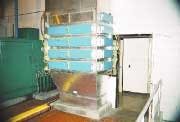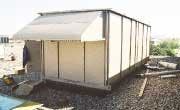Cost comparison of polarized air ionization and "end of pipe" systems as applied to sludge dewatering buildings with a maximum of 10 ppm H2S.
Click here to enlarge imageThe system has a minimal footprint and power requirements of 35 watts per module. The system has zero water usage and no chemical handling or storage. In addition to providing odor control and a safe work environment, air ionization prevents corrosion of electronics and equipment. Both capital and operating costs were found to be less than other options such as wet scrubbers, activated carbon, and biological treatment.
Case Study
The Denver Metro Wastewater Reclamation District installed air ionization supplied by Trans-Tech as part of the High Solids Cake Storage Improvements Project which included the new ionized air handling system for the sludge processing building basement, completed in September of 2003, and the cake storage building and conveyor section, completed in January 2004. The MWRD project involved a major upgrade to high solids centrifuges.
The dewatered sludge is dumped onto a serpentine conveyor belt and transported on open belts through a conveyor section to a cake storage building where it is dumped into large hoppers or tanks for storage and trucking off site. The main goal of air ionization was improved worker safety and corrosion protection along with odor control as an additional objective.
The success of a pilot test run in house by MWRD, led the district to request Black & Veatch to investigate all aspects of the technology, including safety, effectiveness on a variety of organic gases, previous testing for ozone, reliability, and operation and maintenance costs. After reviewing available literature, and other US installations, Black & Veatch approved the technology for application at MWRD's 26,800 cfm sludge processing building basement and the 16,700 cfm cake storage building.
System Results
For the final design, MAU-7, a 20,200 cfm air handler with high efficiency filters, was installed on the roof of the sludge processing building to provide supply air to the basement through ionization plenum AIU-2. For the sludge building basement, a total of 24 model 50F5 ionizer modules are installed in two separate plenums. Plenum AIU-2 houses 18 modules, and an additional plenum AIU-1, 6,600 cfm being supplied air by air handler MAU-1, houses 6 modules. Both plenums are positioned on the centrifuge room floor directly above the basement. The ionizer modules are flange mounted to the plenum and can be removed for routine maintenance in a few minutes.
Ionized air is discharged over the walkways on the north side of the basement via carefully designed and positioned air inlet registers, while spent air is exhausted from the south side of the basement. An air ventilation rate of 12 air changes per hour is maintained. Additional ionized air is discharged through ducts mounted directly at the sludge drop zones.
At the cake storage building, a single plenum of 24 50F5 modules is employed. For the conveyor section, four shelf mounted model 70E5 units with integral fan are positioned at intervals along the conveyor.
After startup, compliance testing for H2S levels was performed using a factory calibrated Industrial Scientific TMX412 for all air ionization systems based on achieving a requirement of less than 4 ppm in the walkways and general work areas. The compliance testing demonstrated that air ionization reduced H2S to non-detectable concentrations in all areas including the sludge processing building basement walkways, fresh sludge dump zones at the conveyor belt, cake storage building penthouse, and directly above the dump zone where sludge dumps from the conveyor belt into the cake storage tanks.
Subsequent to the compliance testing, additional testing was performed by Black and Veatch to measure odor for purposes of information. For odor sampling, the St. Croix Sensory field olfactometer or "Nasal Ranger" was used. This instrument measures fresh air dilutions to odor detection or D/T.
Odor levels were low in the walkways and work areas, 2-7 D/T. Odor six inches above the fresh sludge on the belt, 30 D/T. Stack outlet odor being discharged measured 15 D/T, which is considerably less the typical stack emissions limit of 300 d/t, which might be achieved by other "end of pipe" treatment devices such as wet scrubbers or biofilters. The added advantage of air ionization is the improved interior air quality, which would not be obtained with end of pipe treatment.
MWRD is pleased with the performance and operation of the air ionization system. The sludge building basement, which was previously very uncomfortable for operators, is now a pleasant workspace. Facility Engineer Mike Carver now includes the basement on plant tours, so that visitors can witness the superior air quality provided by air ionization.
About the Authors:
Dennis Tulenko, REM, is President of Trans-Tech Energy and Environmental. He is a Registered Environmental Manager and has worked in air pollution control for over 20 years. Gayle Van Durme, P.E., is a Senior Process Engineer for Black and Veatch in Kansas City, MO. Michael Carver, P.E., is Facility Manager for the Metro Wastewater Reclamation District in Denver. For more information on air ionization technology, visit Trans-Tech's web site at www.trans-tech.org.





